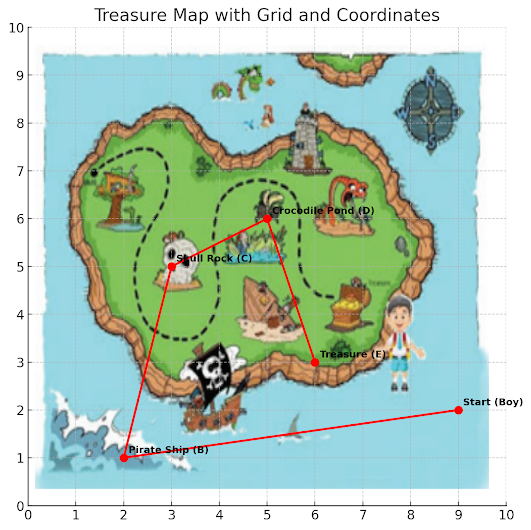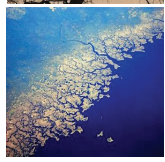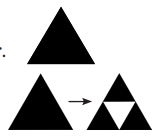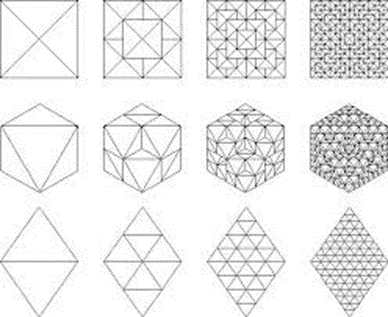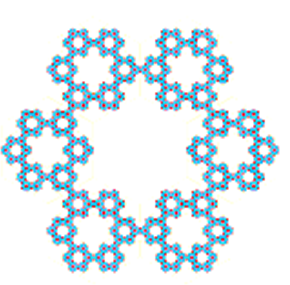Activity W3.3 A Treasure Hunt
Provide each student with a copy of the treasure map, which includes coordinates (i.e., pairs of numbers discussed in earlier activity) marking the location of the treasure.
Explain the objective of the activity: to use the given coordinates to locate the treasure.
Allow students to work individually or in pairs to navigate the map and find the treasure.
Once the treasure is found, celebrate the successful completion of the hunt and discuss the coordinates used to locate the treasure.
Encourage students to create their own treasure maps for future activities, incorporating coordinates and landmarks of their choice.
Creating patterns and designs with rotational and reflection symmetry Symmetry is a property where one shape or arrangement can be transformed into another that looks the same.
Let’s imagine this map uses a simple grid system: the bottom left is (0,0) and the top right is (10,10). Here's how we can place the main points:
-
Starting point (where the pirate boy is) — (9,2)
-
Pirate Ship — (2,1)
-
Skull Rock — (3,5)
-
Crocodile Pond — (5,6)
-
Lighthouse — (7,9)
-
Dragon Cave — (8,6)
-
X Marks the Treasure — (6,3)
Path to the Treasure:
-
Start at (9,2) — The boy.
-
Head southwest to the Pirate Ship at (2,1).
-
Move north to the Skull Rock at (3,5).
-
Go northeast to Crocodile Pond at (5,6).
-
Move southeast to reach the Treasure at (6,3).
Named Points:
-
A (9,2) — Start
-
B (2,1) — Pirate Ship
-
C (3,5) — Skull Rock
-
D (5,6) — Crocodile Pond
-
E (6,3) — Treasure!
So the final treasure is at Point E (6,3).
New Route & Coordinates:
-
Start (Boy) — (8,3)
-
Dragon Cave — (7,7)
-
Snake — (5,7)
-
Water Pond — (5,6)
-
Skull Rock — (3,5)
-
Pirate Ship — (4,2)
-
Lighthouse — (6,8)
-
Crocodile Pond — (2,6)
-
Treasure — (7,4)
New Story Clues:
Clue at Start (8,3)
"Ahoy, young adventurer! Your journey begins where the sun meets the sea. Seek the ship with black sails, it waits for thee!"
"The journey starts at the shore's embrace, where adventure waits at a dragon's place."
"Set sail from the sandy shore, a bony face waits at place four."
🐉 Clue at Dragon Cave (7,7)
"The dragon sleeps but the path's not done, follow the glow of the rising sun!"
"A dragon's roar guides the way, to a slippery friend where secrets lay."
"A fiery friend guards the way, but thirst leads the next display."
Snake (5,🐍 Clue at Snake (5,7)
"Slither and hiss, the serpent's near, climb to the light, the path is clear!"
"Slither past without a sound, where water glimmers, treasure's bound."
"Slither past without delay, crocs await along the bay."
💧 Clue at Water Pond (5,6)
"Cool waters and ripples wide, but snakes nearby know where riches hide!"
"A drink for the weary, cool and clear, look for the skull that whispers fear."
"Cool water to quench your thirst, but to see the light, climb first."
💀 Clue at Skull Rock (3,5)
"A skull of stone watches the shore, to quench your thirst, seek water and more."
"The rock with eyes has seen it all, now sail to the ship that heard the call."
"The silent skull hides no lie, the ship with sails is nearby."
🦜 Clue at Pirate Ship (4,2)
"Ye found the ship, brave and bold, but the treasure's still untold. Beware the crocs — to the swamp you must go, where the water runs slow."
"Yo-ho-ho! But not yet gold — the lighthouse stands, so brave and bold."
"From deck to cave, the dragon's near, brave the beast and show no fear."
💡 Clue at Lighthouse (6,8)
"From this tower the sea is seen, but the dragon guards what's golden and green!"
"High and bright, it lights the way, where crocs are waiting to lead astray."
"From atop the world so high, the slithering snake is nearby."
🐊 Clue at Crocodile Pond (2,6)
"Snap and splash, the crocs do play, the skull-shaped rock points the way!"
"Snap and splash, the final clue! Head to (7,4) for the treasure true."
"Watch your step at the snapping jaws, the treasure waits with pirate laws."
🏴☠️ Final Clue at Treasure (7,4)
"X marks the spot, you’ve braved the quest, dig right here for the pirate’s chest!"
"You've solved the riddles, faced each test, dig here now and claim your chest!"
"X marks the spot — dig, and the chest is yours!"

